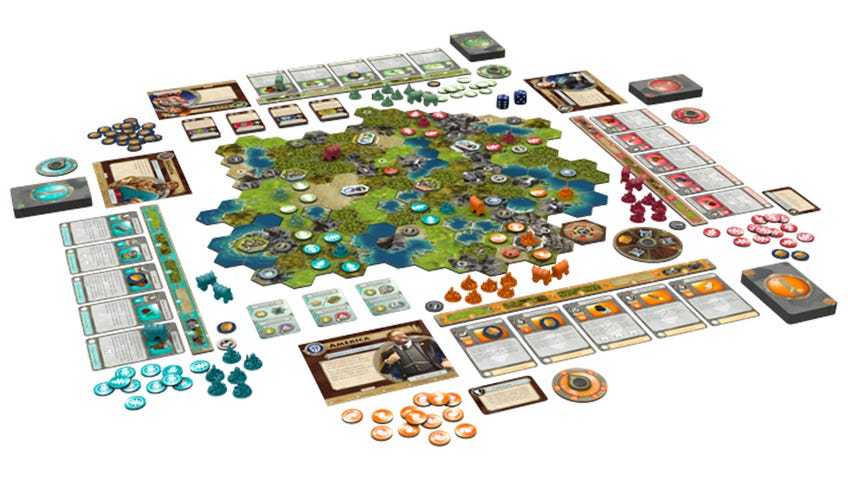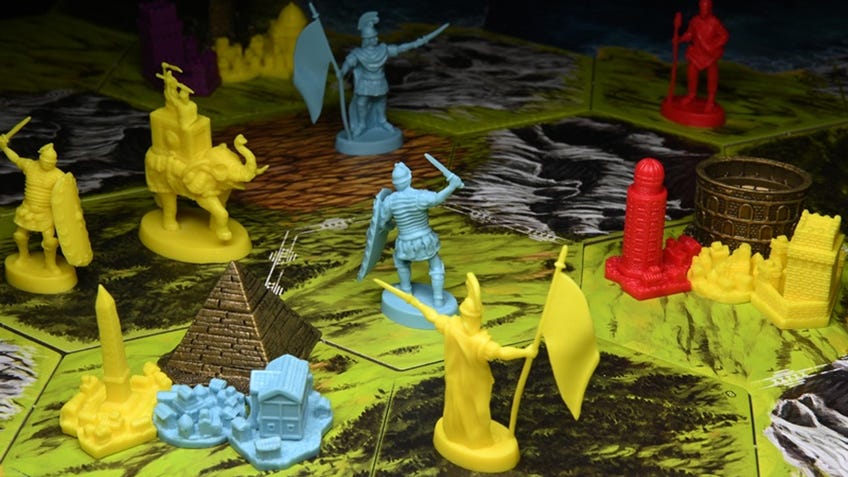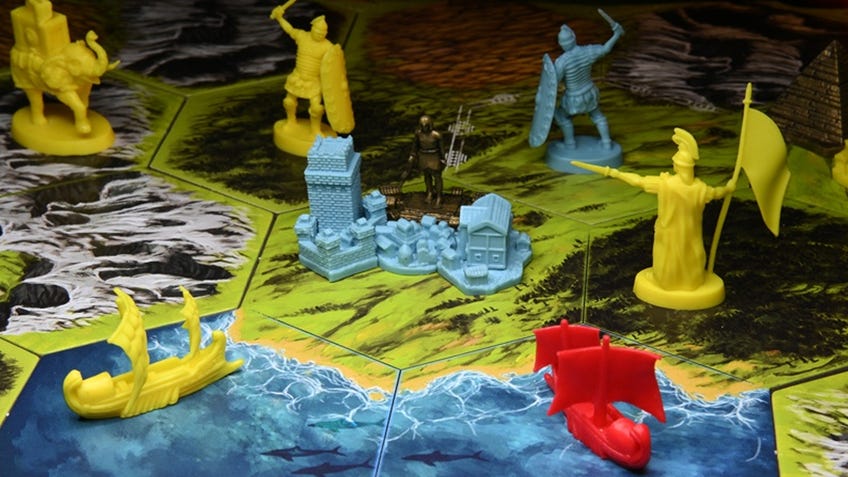Clash of Cultures is the greatest Civilization board game without Sid Meier in its name
You have discovered Entertainment.
The history of Civilization - the game, not the whole of human development - on the tabletop is, fittingly, a long and complex one.
The most widely-known iteration of the classic civilisation-building genre, long-running PC game series Sid Meier’s Civilization, owes a heavy debt to the relatively little-known but enormously influential 1980 board game by late, great designer Francis Tresham. (Perhaps its comparative obscurity is in part because Tresham, unlike Meier, kept his name off the box, leaving the generic mononym.)
The popularity of Sid Meier’s Civilization means the video game is, by extension, likely the best-known civilisation-building board game on the tabletop, too. This is despite the fact that civilisation games are far more plentiful in cardboard than code, with everything from card game 7 Wonders to Scythe creator Jamey Stegmaier’s Tapestry dipping a toe into the epic strategy genre typified by recreating humanity’s progression from inventing the wheel to blasting off into space (and beyond).

While the multiple games bearing the moniker of Sid Meier’s Civilization: The Board Game are still the most faithful to their namesake, in 2023 their complex rulesets feel increasingly unwieldy and imposing for the average PC player looking to jump across to the tabletop.
In fact, the most recent addition to the series-within-a-series, Sid Meier’s Civilization: A New Dawn, is excellent because it isn’t beholden to trying to copy the PC game one-for-one. Players’ control of their civilisations’ many aspects is abstracted into a row of action cards, with just one action performed each turn. It’s an elegant, modern and approachable way to preserve the feel of Civilization in a two-hour game, without remaining tied to its weightier mechanical baggage. (Its expansion, Terra Incognita, adds some optional complexity that brings it closer to the on-screen Civilization 6.)
If you’re committed to playing a board game with the name of Sid Meier on its box, and don’t mind something that veers away from the exact experience, A New Dawn is the best place to start today.

But if you’re willing to part with the familiar, there’s another civilisation game out there. One that balances the accessibility and elegance of A New Dawn with the more traditional gameplay of original Sid Meier’s Civilization. That game is Clash of Cultures, the best (Sid Meier’s) Civilization game that isn’t Sid Meier’s Civilization.
Clash of Cultures balances the accessibility and elegance of A New Dawn with the more traditional gameplay of original Sid Meier’s Civilization.
First released back in 2012, Clash of Cultures is Sid Meier’s Civilization with the serial numbers filed off. Everything from Civ is here: you take control of a unique civilisation from human history, settle new cities across the map, discover new technologies and advance your cultural, military and economic might across vast eras. There are pesky barbarians to deal with, random environmental and societal events that can wreak havoc (volcanoes, famine, disease), and the thrill of discovering why mundane inventions like irrigation are quite important, actually.
Some of Civ’s more complex elements are present in the 4X board game, too. Each city has a happiness level, which can affect its productivity, and a city’s surrounding terrain influences the resources it can gather - ore comes from mountains, wood from forests and food from plains, but you’ll need irrigation (told you it’s important!) to make use of barren land. There’s a surprisingly detailed city-building aspect, too; the buildings you construct in a city affects its abilities, such as requiring a port for fishing or a market to build more advanced military troops (when playing with the original game’s expansion, bundled in the recent Monumental Edition by default).
As you’d expect, the game’s arc is propelled by the technology tree central to the genre (pioneered by Tresham’s seminal board game) along which players guide their civilisation. Investing in certain techs - called advances here - unlocks others, along with new turn-to-turn powers and buildings to add to your city.
The board game feels suitably epic in scale and deep in its strategy, without being a bear to play.
While keeping track of the various effects tied to the dozens of possible advances is Clash of Cultures’ densest thicket of minor-rules weeds, the board game as a whole is pleasingly simple for the genre. Players get three actions on their turn, choosing between buying a new advance, activating cities to collect resources or build something (troops or buildings), moving military units around, founding a new city using a settler unit, increasing a city’s happiness (by spending matching tokens), or attempting to spread their civilisation’s culture to nearby cities - a simple die roll that nets them extra victory points on a success.
Each action is by itself very straightforward - even combat is a lightweight affair of rolling dice to see how many enemies you defeat, with the chance to play a helpful ability card - meaning that turns never feel like the multiple decades they represent in-game. Event cards are triggered whenever a player places three cubes on their board, meaning that the pace of the game is controlled by the players themselves - rather than leaving you struggling to keep up with spawning barbarians and disasters. Every three rounds, players score for unique objectives in their hand and gain a free technology, avoiding the sense of falling behind.

The result is a board game that feels suitably epic in scale and deep in its strategy, without being a bear to play. A match of Clash of Cultures will still take you several hours to finish in full, but it doesn’t drag on or become bogged down in tiresome rule-checking. Those familiar with losing an entire night to Civilization 5’s hours-zapping timesink will feel the call of “one more turn” here.
It’s also worth saying that the game’s latest Monumental Edition is a visual treat on the table, with vivid artwork and dozens of miniatures to represent players’ differing units. The cherry on top of the game’s physical feast are its 3D buildings, the curved edges of which fit snugly around the basic settlements at each city’s centre and make the growing metropolises look distinct - the round dome of a temple here, the towering height of an obelisk or observatory there. The game’s wonders similarly pop off the table with 3D miniatures finished in gold, making the pricey constructions feel worth their in-game cost.
Clash of Cultures is a stellar civilisation game, one that deserves just as many plaudits and players as the adaptations bearing Sid Meier’s name. If you’re after something that understands why the civ-building genre has remained a fixture of both tabletops and computer screens for decades, but won’t take an age - or, indeed, ages - to play, you can’t go wrong.


